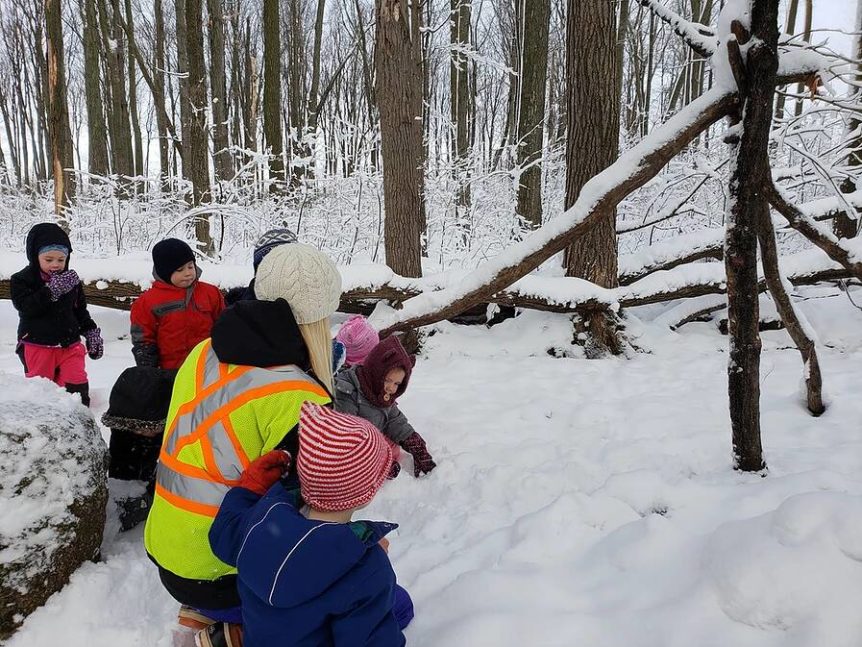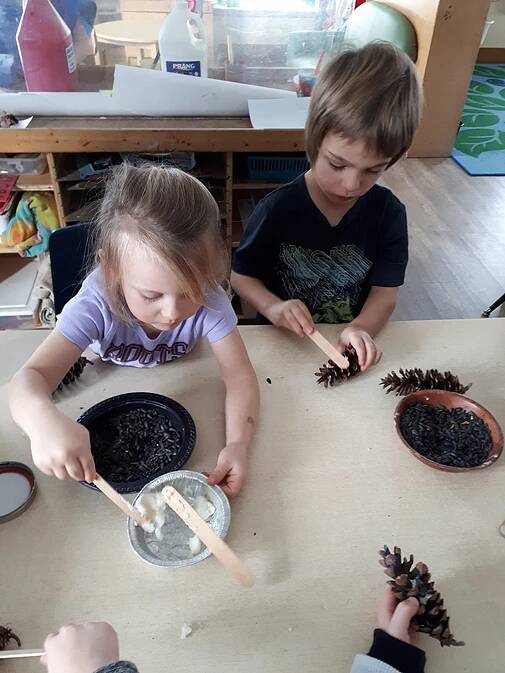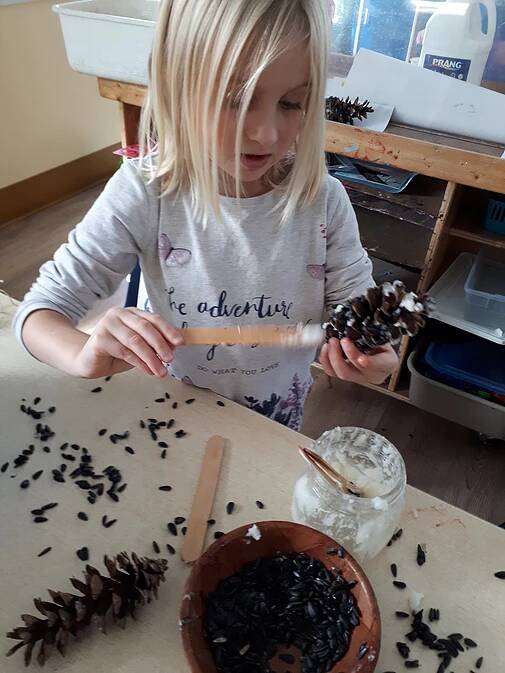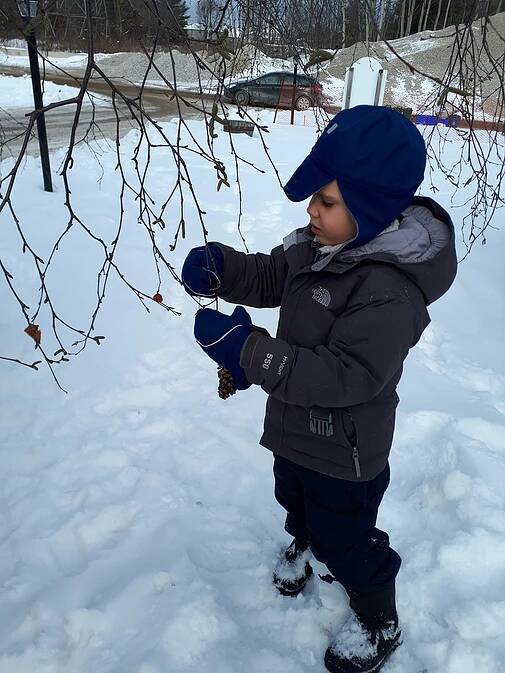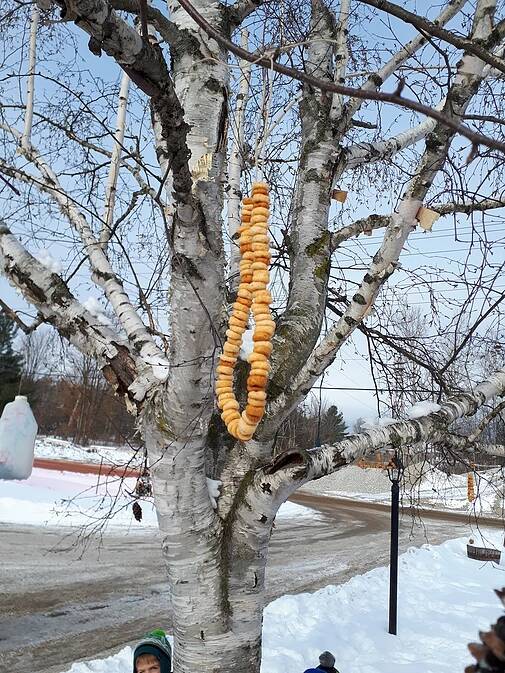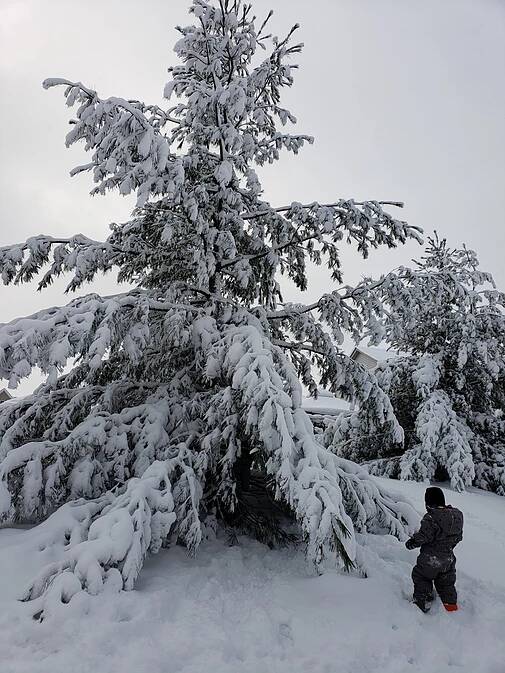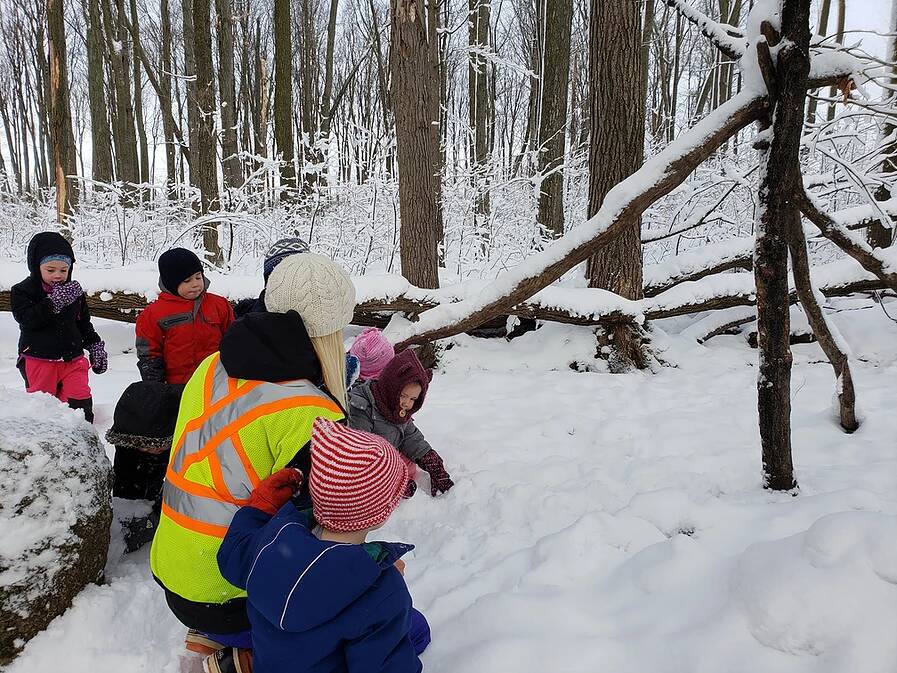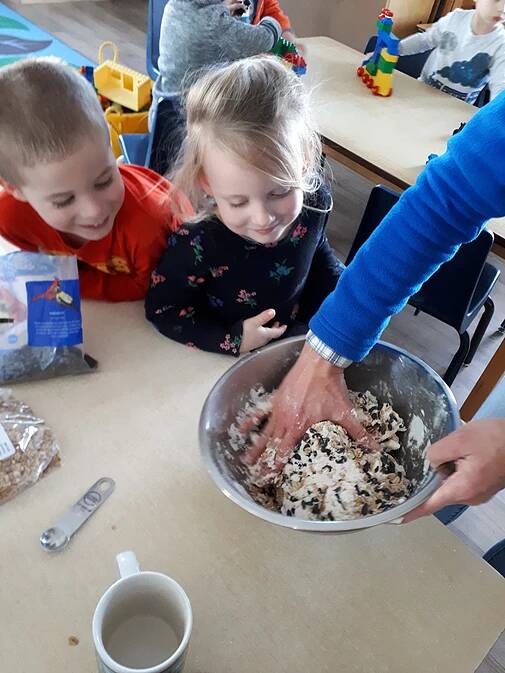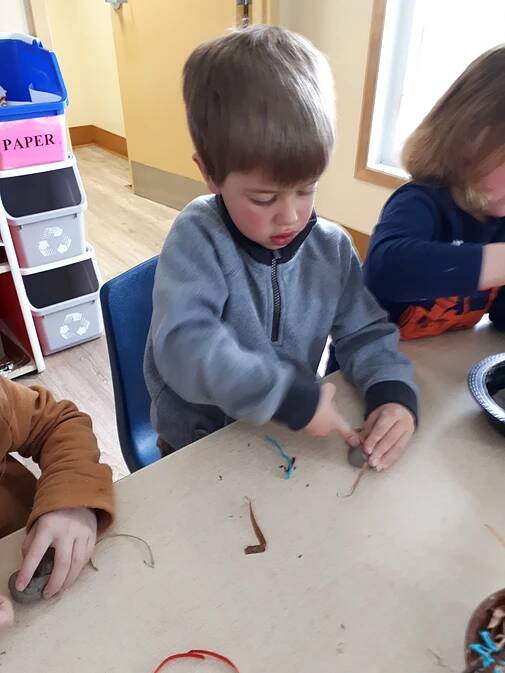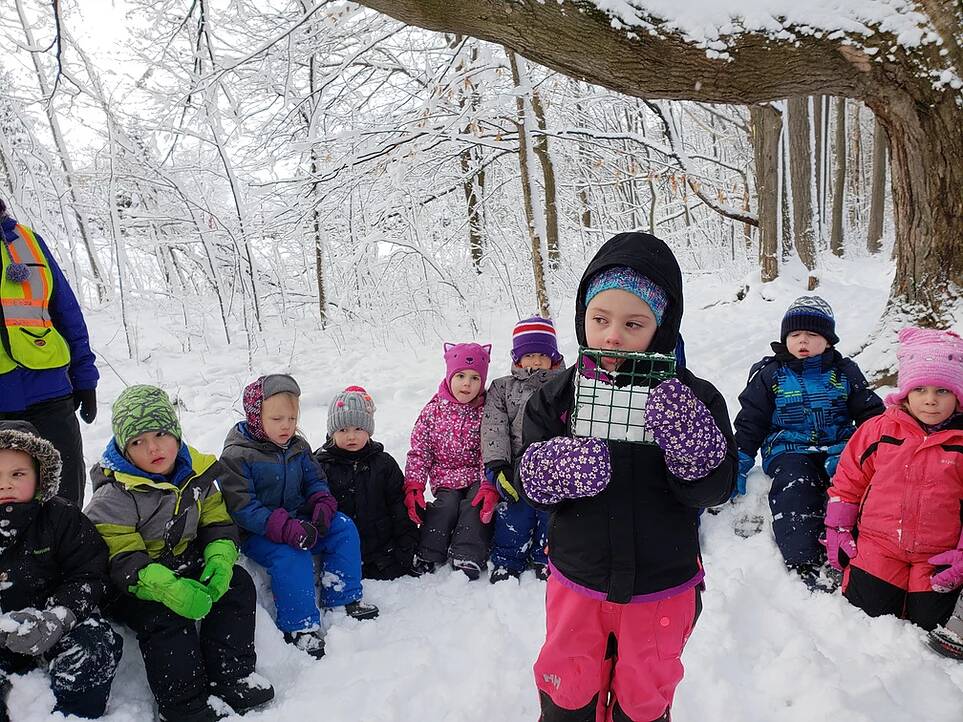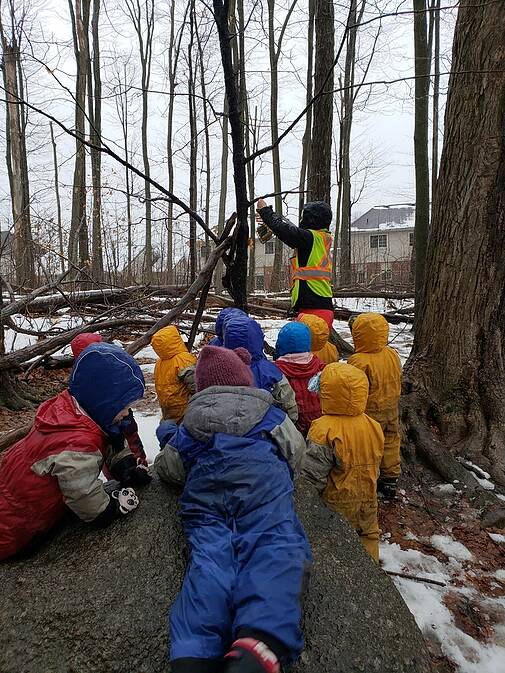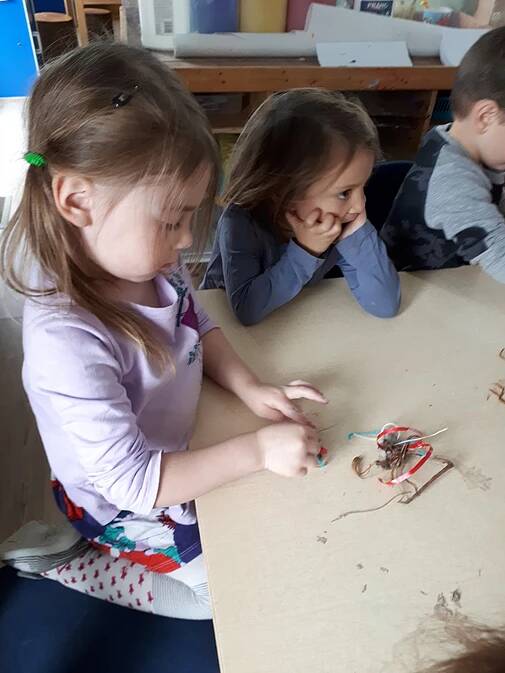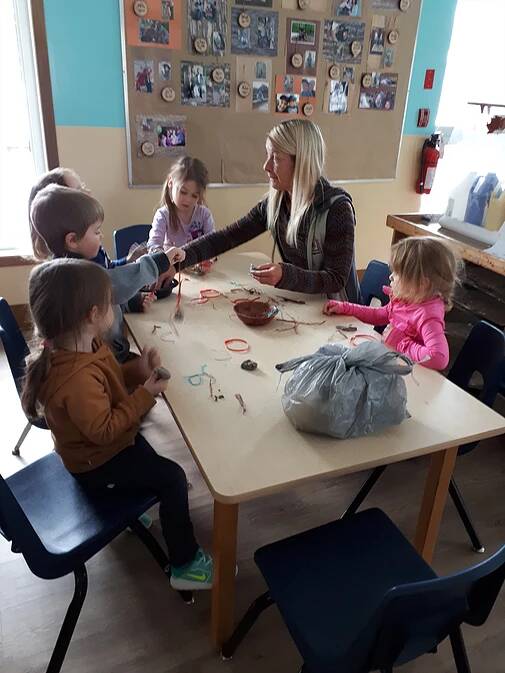After feeding the forest animals our pumpkins and creating bird feeders with our gourds, we started to notice the birds in our forest and outside our windows a the centre. There were a lot of chickadees moving the snow from our gourd feeder and we started to really notice their actions as they worked to find the seeds. This lead us to a conversation about the birds we know and what we know about them. We know that birds have feathers, live in trees, lay eggs, fly and some fly away in winter.
AH brought a bird’s nest in from home that she and her family had discovered. She was really excited to share it with everyone and we were sooo excited to have an up close look at it as she shared it with us at circle. We examined the contents of the nest and noticed that the bird had used grasses, twigs, mud, some fluffy stuff and even a piece of ribbon. We talked about why birds make nests and came up with great ideas. One of our friends suggested “because that is their home” while a few others were sure it is so they could have a place to lay their eggs. We discussed how the mommy bird sits on the eggs to keep them warm while the babies grow inside. We read the book “Are you my Mother?” which helped us remember the kinds of things birds like to eat including worms, bugs, berries and seeds. We also talked about how different birds make different sized nests and some even live in holes in trees.
We decided to try our hand at making nests ourselves with grasses, yarn, twine, clay and other items at our art table. The clay replaced the mud the birds would use and, as we manipulated it and the other items, we quickly realized that nest making was hard work!
Each nest was really unique and we were really proud of how they turned out! Later, we identified some local birds in photographs at our art table as we constructed more nests using glue, paper and all kinds of nature items while discussed the different colours, sizes and shapes of the birds in the photos.
We were keeping an eye on JD’s bird feeder outside the window in the birch tree and, with so much bird activity to see, we decided to have a look at our bird poster to see what birds we should make more feeders for our feathered friends. Before we got to work, we decided to listen to some bird calls online. We sat very quietly while we heard the calls of the blue jay and the cardinal. Some of us recognized the the sounds from outside in our forest. We talked about being just as quiet when we are outside in the forest to hear what other birds might be there. We set to work using different ideas and materials to create delicious treats for the birds. At one station, we used Popsicle sticks to spread coconut oil onto pine cones in big, thick globs to which we then stuck sunflower seeds. We pushed them on with our fingers and rolled them into the bowl of seeds before completing them by adding twine for hanging.
Another station had us focused as we used our hand eye coordination as well as out fine motor skills to string multi grain cheerios onto lengths of twine. It was difficult to not eat these ones ourselves! We strung the cereal for what seemed like ages and the result was beautiful!
We also converted one of our used paint jugs into a feeder after making sure it was cleaned well. MB added a colourful touch before we filled it with yet more seeds!
With birds on our minds and our “owl eyes” to the skies, we were really excited to spot a rather large bird in one of the trees at the centre. We quietly approached and tried our best to see what it might be. Was it an owl? A hawk? We couldn’t tell but we were lucky enough to see it as it took flight towards the forest!
It was finally time to hang all of the many different feeders we had made and we chose the birch tree right outside our classroom window for a location. We all helped to hang and even tie the feeders to the low branches of the tree which proved a little difficult with our gloves on. Even so, some of us were able to tie our own knots!
As the feeders went up, one by one, we started to notice little birds coming to see what we were up to. The curious little creatures, we noticed, were chickadees and there were a LOT of them! We decided to see what would happen if we sat super still and quiet under the tree. Sure enough, they came to our feeders! We were so excited that it became more difficult to stay quiet. Our little feathered friends landed on the branches and feeders all around us and just above our heads. They seemed grateful for all of the treats we had brought for them.
We started wondering about ways we could feed and attract birds to our site in the forest and we came up with a really great idea. Every morning, before heading to the forest, we we would make a double decker “bird seed sandwich” to take with us. We used bread, wow butter and birdseed to make the sandwich before placing it into a suet feeder to take with us.
In the forest, we chose a location near our meeting area to hang the feeder before setting off to explore. We listened for birds but none came to visit our feeder that morning. We decided to go for a walk about in the snowy woods and we began to notice all of the different signs of animals as we saw tracks in the snow and all kinds of nests and holes in the trees above.
When we returned for our next visit, with another sandwich to hang, we wondered if the birds had found and enjoyed the one we had left before. We were really excited to find that, not only was our feeder empty, it was on the ground!!! How did it get there?
When we took a closer look, we noticed that the twine we had used to hang the feeder had been broken AND there were all kinds of tracks in the snow. What was going on?
We made some guesses about the tracks, assuming that maybe they were from squirrels as we have seen a few squirrels in our forest. The children decided that a squirrel maybe chewed the twine which made the feeder fall. It seems we are helping more than just the birds find food in our forest and we are really excited about that. We hung the new “sandwich” up and listened for a while before setting off to do something new… sledding! We had brought crazy carpets with us to the forest and, with so much snow, taking advantage of the hill nearby seemed the right thing to do! We spent the entire morning taking turns and sharing as we used all kinds of muscles to hold and stay on the crazy carpets as we whizzed down the hill! We tried different ways of sliding including on our bums, with a friend and even on our bellies!
We noticed that the trees at the top of the hill were evergreen trees like we had talked about before. They smelled like Christmas trees and we noticed, too, that the chickadees were hiding them, watching us as we played. Some of us joined the birds as we crawled beneath the pines while others filled our hands with bird seed and stood still to see if they would come to eat. The excitement of the sledding took away from our patience to stay still for long so we tossed the seeds beneath the trees for the birds to find another time. We did try to sneak in to see our feeder in the forest but we didn’t chance to catch any animals in the act of feasting.
Back at the centre we started to talk about why we help to feed the birds in winter. Did you know that some birds fly south for the winter months? We learned that this is called migration and that some birds do this because the food sources such as berries, seeds and bugs are limited in winter and they leave to find places where they will have enough to eat. Some birds stay throughout the cold winter months and adapt to the change of seasons. This is called adaptation and these birds often rely on our help to find food in the form of seeds, fruit and nuts to help them through the cold months of winter. We decided to list the birds we see in winter including chickadees, woodpeckers, cardinals and blue jays as well as the ones we see only in warmer weather such as robins, hummingbirds and geese. We learned that other animals migrate and adapt too in different ways and that some even sleep for the winter! We are curious about this because it may help us to identify some of the tracks we have been finding in the forest. We explored some of these tracks and many others with our animal track stamps in the classroom as we worked together to identify them.
We decided we should hang a second birdseed sandwich feeder outside our classroom window as we have noticed some birds out there despite the construction happening in front of the centre. We can’t wait to see what birds visit and what new tracks we may find! In the meantime, we decided to make our own “bird bread” for our “bird seed sandwiches”. We can’t wait to see what birds or other wild friends it may attract!

